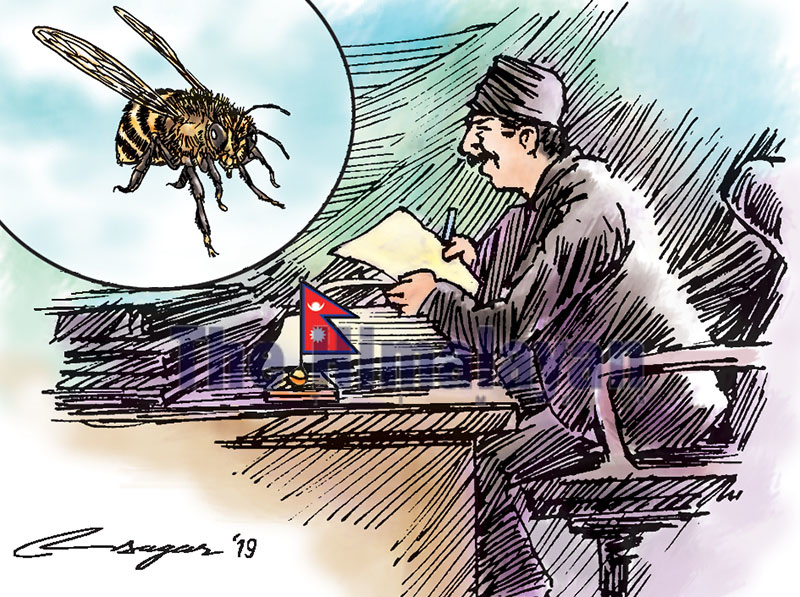Democratic decision-making: Learning from ‘honeybee democracy’
Honeybees make decisions without the queen telling them what to do. However, in our political system, the leaders are expected to take all the decisions, and are criticised if they fail to do so
Democratic decision-making is an appealing idea being advocated by all the major political parties and other actors in Nepal. In the preamble of Nepal’s constitution, it is stated that we are committed to socialism based on democratic norms and values, including the people’s competitive multi-party democratic system of governance. It is, however, quite common that decisions are often made without participation and due consultation with the concerned stakeholders.
Honeybees are referred in a number of political discourses, such as ‘busy as a honeybee’ and ‘defend as bees do with wasps’. This article highlights how honeybees take decisions and whether their organisational system and decision- making process can help us bring positive changes in our decision-making.
Honeybees are known to us as social insects, as they work together and store honey in their combs, much more than they actually need to survive. And, humans have prized these small creatures since ancient times. Honeybees have a clear division of tasks (cleaning of hive, brood caring, defending, nectar and pollen collection, processing and storage) based on age, caste (worker, drone and queen) and need. The Nobel Laureate, Karl von Frisch, elucidated the ways honeybees communicate information to each other about the source of honey and distance to reach there. Scientists have always been fascinated about this evidently programmed complicated mode of communication.
In recent years, Thomas D Seeley, Professor at Cornell University, revealed that bees have something to teach us about the power of democratic decision-making. Based on his decades of research, he shows that the inner operation of a honeybee colony is not governed by a queen; instead the work of a colony is governed collectively by the workers themselves.
In his book ‘Honeybee Democracy’, Professor Seeley vividly explains how a colony achieves near-perfect accuracy when it selects its home, and how tens of thousands of worker bees, through enlightened self-interest, cooperate to serve a colony’s common goal. He suggested following five lessons that we could learn from bees about making better group decisions. They are: Compose a decision-making group of individuals with shared interests; minimise the role of the leader; seek diverse solutions; debate, debate, debate; and use quorum for an accurate and speedy decision.
While selecting a home to build a nest, honeybees form a group of ‘scout’ bees consisting of old and experienced worker bees. Based on information provided by the scout bees on different locations, the worker bees collectively decide which site to choose. The 2nd Constituent Assembly should have been an opportunity for the members to form a small team to come up with the draft constitution, to be shared, discussed and endorsed by all. Honeybees make decisions without a leader. The queen sits on the sidelines, and the group makes decisions without a leader telling them what to do.
However, in our political system the leaders are expected to take all the decisions, and are criticised if they fail to do so. Generally speaking, the leaders function as the boss, conducting meetings in a directive way and expressing displeasure if there are disagreements or if the discussion is not going in the set direction. Though they have created some kind of mechanism for taking collective decisions with broader participation and summed knowledge, in practice, however, decisions are made as per the wishes of leaders and organisational heads.
On the other hand, honeybees look for diverse options before taking any decision. For instance, before a honeybee colony decides to swarm and find a new home for building a nest, the bees will explore miles of territory and up to 20 possible places to live. Debate is a part and parcel of the decision-making process in a honeybee colony. Before a decision is made on the best site, there is often disagreement among the honeybees about which nest is the best candidate – the roomiest, sunniest and highest off the ground. People, too, should engage in a spirited and civil exchange of views. In short, there should be open and public competition of ideas, but, like the bees, each person should make a private and personal evaluation of the ideas.
Using a quorum for accurate and speedy decisions is also an important lesson we can learn from the honeybees. Unanimity is not always the answer when it comes to effective group decisions. The bees, therefore, use quorum sensing to make a speedy, yet accurate decision. Humans, too, can employ this tactic by periodically polling a group to see how close it is to agreement. If far from unanimity, then more debate is needed, but if only a small minority remains in support of a position, then further debate may be pointless, and it is better to switch to the majority and achieve consensus. In the name of unanimity, we should not be wasting a lot of time.
Another important lesson we could learn from the honeybees is that the leader should refrain from advocating any solutions he or she would like to see adopted and instead should exhibit an open- minded desire for fresh ideas. The leaders should acknowledge the fact that there could be diverse solutions for a single problem, and the more they use group intelligence, the better decision options they can provide.
Joshi is a honeybee expert






